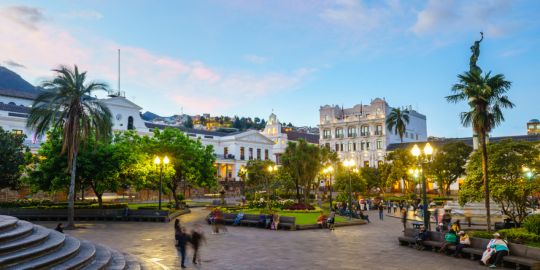Between 2017-2018, 46 percent of Ecuadorians worked informally. This is 2 percentage points higher than 2016-2017. In the capital, this increase is easily seen as there are more informal workers on the streets. Exasperating the problem are Venezuelans who also resort to informal work, mainly selling cheap merchandise and food items. They are in essence competing with the poorest segment of society.
So, why all the informal workers?
The obvious answer is a bad economy as there are not enough jobs that pay at least the minimum salary or $394 per month. Underemployment is a specific factor, and older people between 45-64 years of age are particularly affected by underemployment as they comprise 29.6 percent of all underemployed. Men in particular as they make up 61 percent of the aforementioned percentage. We can truly say that Ecuador is No Country for Old Men with regards to employment.
What's interesting, however, is that the increasing trend of informal work not only affects Ecuador, but also the region. For example, in Argentina 47 percent of population also works informally. In Mexico, the number is 53 percent and in Chile, it's 40 percent.
Source: El trabajo informal emplea al 46% de la población en el Ecuador
46 percent of Ecuadorians work informally
You gave the older age group a percentage of the under employed but not a percent of the population the employable population. In other words, could you give in the underemployment rate in the older group and the underemployment rate in the older group.
It's also a problem in Colombia, and even worse - estimates are that over half work informally and in this article they state that according to the Organización Internacional del Trabajo it's 61.3%, the highest in the world. How they know it's 61.3% and not 61.2%, who knows...or even 59% or 63%, as by the nature of the thing it's impossible to know completely and accurately.
https://www.eltiempo.com/economia/secto … ces-242148
And the minimum monthly salary in Colombia for 2019 is just 828,116 pesos, just under 265 USD.
Bigbrad2008 wrote:You gave the older age group a percentage of the under employed but not a percent of the population the employable population. In other words, could you give in the underemployment rate in the older group and the underemployment rate in the older group.
Ok, good point.
The total working age population is 10,681,725. The older group 45-64 comprises 2,835,213, or basically 26.6 percent. The 29.6 percent underemployment rate for that age group is 3 percent higher than % of population (working). Considering that males 45-64 comprise 61% of underemployed in that age group, we can conclude that they are more affected by underemployment in terms of percentage.
Source of population is Ecuador en cifras. It's a spreadsheet, use MS Excel AutoSum to quickly add numbers.
Thanks, I just like data.
I think service Apps like Glovo, Uber eats, domicilio, uber, cabify, easy taxi, etc are increasingly impacting the informal economy. This type of work is probably on the upper echelons of informal works. If for example on the bottom end is selling donuts or cake from a box on the streets. The investment there is minimal whereas delivering for Glovo you'll need to get paperwork (RUC), pay monthly fee to use the app, glovo container, and either a bike or motorcycle. It's quite interesting to see technology's impact on all segments of society. In Quito, these dudes that work for these Apps actually congregate in certain areas like the parking lot of Pollo campero on NN.UU and Amazonas.
The poor in the developing world is very resilient despite the adversity. They always find a way to put food on the table and carry on with their lives. This is one reason why I abhor seeing young people beg.
Alright, if informal workers are on one end of the economic spectrum who is on the other end?
The rich, or a class of Ecuadorians that many blogging expats at one point were oblivious about. Because claiming to live upper-class lifestyles on middle class budgets is delusional at best. The fact of the matter is that a rich class of Ecuadorians exists.
This rich class consists of old money and new money or nouveau riche. To people who live in the capital, this class is obvious as they drive luxury cars and live in affluent areas like Cumbayork (Cumbayá) as this Ecuadorian columnist puts it. He goes on to state that the nouveau riche have two distinct characteristics, insolence and pretentiousness. Jajajajaja.
Make of it as you will but there is some truth in that. More importantly, it's important that expats understand and accept this reality of a rich class. Doing so, will discredit false online claims that one can live an upper class lifestyle on a middle class budget. IMO, I think part of this false perception is due to some expats living in villages and probably experiencing big fish in small pond syndrome. Or as one member once boasted that on his $800 a month budget he was living better than 90% of Ecuadorians. Clearly, big fish in small pond experience.
Love your posts vsimple. A dash of reality is always a good thing.









